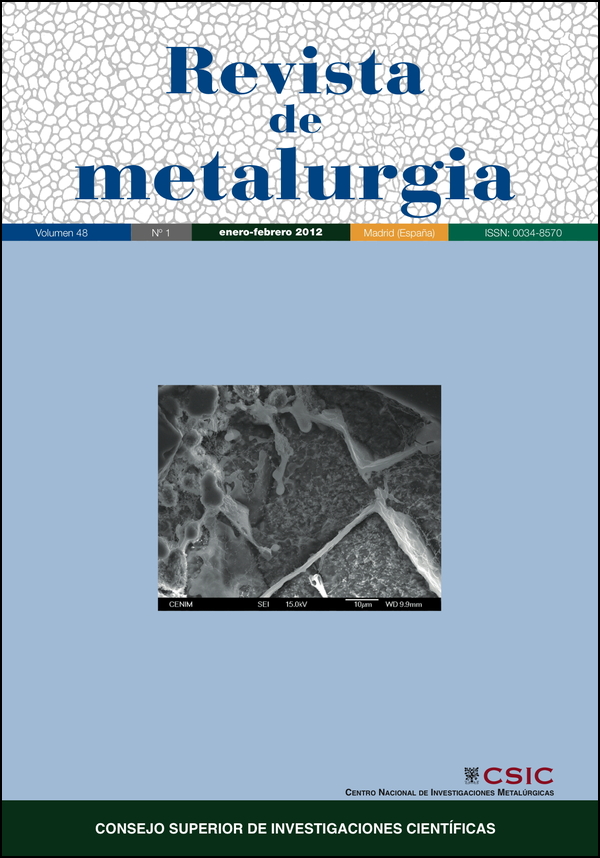Contact stress by the method of finite elements of the steel AISI 1045 hardened by roller
DOI:
https://doi.org/10.3989/revmetalm.1066Keywords:
Plastic deformation, Stress, Deformation, Hardening, SimulationAbstract
In this paper, the tense-deformational behavior is analyzed by means of simulation using the finite element method for AISI 1045 cold rolled deformed steel. ANYSYS V.10 software was used in this study. Revolution number, compressive strength and tool feed rate were the variables considered in the deformation process. They allowed determining the contact stress of the deformed material. The material used was 30 mm diameter and 100 mm length. Samples of 30 mm diameter and 3 mm thickness were prepared for the optical microscopic observation, which were compared to the results obtained from the simulation. The tensile status of the deformed samples was evaluated as from the reduction of the average size of the grains as per the strength applied. This study intends to show that the cold hardening method is a surface hardening option.
Downloads
References
[1] E. Álvarez, J. Lancestremere, J. Mareglia y J. Barr, Rev.Tec. Mec. 20 (2004) 69-76.
[2] S. Rose, Soc. Manuf. Eng. 3 (2000) 16-38.
[3] T. Gabb, J. Telesman, P. Kantzos y P. Prevey, Adv. Mater. Process. 160 (2002) 69-72.
[4] C. Barret, Estructura de los metales, (1ª Ed.), Ed. Aguilar, Madrid, España, 1957, pp. 532-550.
[5] B.D. Cullity, Elements of X-Ray Diffraction, (3ª Ed.), Ed. Addison-Wesley Publishing Company, Inc. American Society for Metals, EE.UU. 1967, pp. 248-253.
[6] J. Caubet, Teoría y Práctica Industrial del rozamiento, (3ª Ed.), Ed. Aguilar, Madrid, España, 1971, pp 229-243.
[7] A. Guliaev, Metalografía, Tomo I, Ed. Mir, Moscú, Rusia, 1983, pp. 53-89.
[8] L. Korotcishe, Procesos progresivos en la deformación plástica superficial por rodadura, Ed. Mir, Moscú, Rusia, 1989, pp. 53-64.
[9] S. Hernández, Metodología de la Investigación, Ed McGraw - Hil, México, 1997, pp. 132-145.
[10] T. Ingham y E. Moreland, Industrial Quality Control 1 (1983) 26-31.
[11] W. Alfaro, Simulación de procesos, Monografía 15 Vol. 15 (2001) En: http://www.monografías.com/trabajos6/.
[12] J. Bhate y N. Dvorkin, Prentice Hall, 1 (1984) 77-78.
[13] V. Thomée, Galerkin finite element methods for parabolic problems, Springer Verlag, Berlin, 6, 1997, pp. 432-442.
[14] H. Huang y A Usmani, Finite element analysis for heat transfer, Springer-Verlag, Berlin 98, 1994, pp. 35-38.
[15] O. Boada, S. Díaz e Y. Campos, Rev. Ing. Mec., 6 (2003) 53-58.
[16] V. Belozerov, A. Makhatilova y V. Subbotina, National Technical University, 38 (2006) 144-148.
[17] A. Bower y K. Johnson, Sol. Phys. 37 (1989) 471-493. http://dx.doi.org/10.1016/0022-5096(89)90025-2
Downloads
Published
How to Cite
Issue
Section
License
Copyright (c) 2012 Consejo Superior de Investigaciones Científicas (CSIC)

This work is licensed under a Creative Commons Attribution 4.0 International License.
© CSIC. Manuscripts published in both the printed and online versions of this Journal are the property of Consejo Superior de Investigaciones Científicas, and quoting this source is a requirement for any partial or full reproduction.All contents of this electronic edition, except where otherwise noted, are distributed under a “Creative Commons Attribution 4.0 International” (CC BY 4.0) License. You may read here the basic information and the legal text of the license. The indication of the CC BY 4.0 License must be expressly stated in this way when necessary.
Self-archiving in repositories, personal webpages or similar, of any version other than the published by the Editor, is not allowed.


















